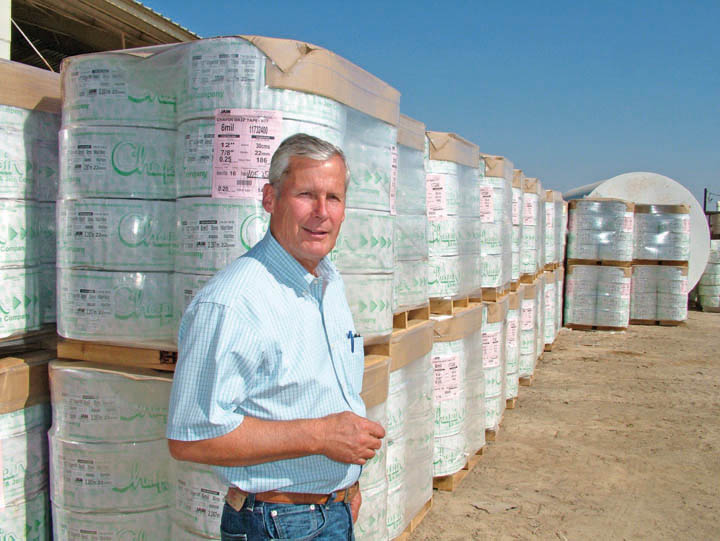
Cotton paves way for SJV cornucopia
In recognition of his leadership in California agriculture, and his accomplishments in cotton production, Don Cameron, Helm, Calif., was selected as winner of the 2012 Farm Press/Cotton Foundation High Cotton Award for the Western states.His farming career has been an ongoing initiative in reclamation, over time fostering a cornucopia of crops. Soil amendments — gypsum, soil sulfur and occasionally sulfuric acid — along with persistent salt leaching and application of 35,000 tons of chicken litter annually from nearby poultry operations, have created land that will grow just about anything.
January 5, 2012

Don Cameron’s three decades of farming on the West Side of California’s San Joaquin Valley can be defined by the numbers 3 and 26.
When the 59-year-old California native started farming near Helm in 1981, his crop list totaled three: cotton, small grains and alfalfa (and two of those were iffy on some fields at Terranova Ranch).
“We had fields where alfalfa and wheat wouldn’t grow” because the white soils were virtually devoid of nutrients and loaded with salts, says Cameron, who grew up in Redding and Fresno, where he graduated from high school, then went to California State University, Fresno to obtain a degree in biology
Today, his crop maps identify 26 crops on the 7,000 acres he farms under the banners of Terranova and Prado Farms.
Crops like carrots, a multitude of seed crops, 1,000 acres of wine grapes, onions, 1,600 acres of processing tomatoes contracted to four canneries, prunes, pistachios, almonds, walnuts, and many more now flourish where wheat would once not germinate.
In recognition of his leadership in California agriculture, and his accomplishments in cotton production, Cameron was selected as winner of the 2012 Farm Press/Cotton Foundation High Cotton Award for the Western states.
His farming career has been an ongoing initiative in reclamation, over time fostering a cornucopia of crops. Soil amendments — gypsum, soil sulfur and occasionally sulfuric acid — along with persistent salt leaching and application of 35,000 tons of chicken litter annually from nearby poultry operations, have created land that will grow just about anything.
“We have always turned under crop residue, and that has helped tremendously,” Cameron says. “Years ago, when growers used to burn wheat stubble, we turned it under. Now most everyone does.”
Year after year of growing deep-rooted cotton and alfalfa also opened up the ground as roots bore into the tight soils, creating tunnels for deep water penetration and leaching.
“It takes a lot of time to reclaim ground,” Cameron says, but it has resulted in limitless cropping options today.
Diversification
Diversification keeps the books balanced. “Several years ago we sold grapes for $80 per ton — we couldn’t give away wine grapes back then. Today, wineries are calling for grapes.”
Prices for SJV wine grapes are triple and quadruple what they were just a few years ago. Markets for many of California’s specialty crops can be fickle, and growers hope to have at least some that are in demand in any given year.
“When we started farming here, it was so salty the soils would not drain,” Cameron says. “We used to keep a tractor and chains ready to pull out stuck equipment. One year, a disk got stuck in the fall and the soil was so saturated it was June before we could get close enough to it to pull it out.”
Now, that same ground produces three-bale Acala and Pima cotton and more than 70 tons per acre of processing tomatoes.
Cotton was Cameron’s moneymaker when he started farming there.
“Cotton has bought and paid for a lot of farms on the West Side of the valley over the years,” he says. “Without cotton, we wouldn’t be here farming what we do today.”
But the cotton industry has paid a hefty sacrifice — it almost disappeared as prices faltered and alternative crops flourished economically. Acreage was well over 1 million acres in many years, but when acres fell below 200,000 in 2008, there were fears the crop could be headed for extinction in the San Joaquin Valley after more than 75 years.
Plantings rebounded to a little less than 500,000 acres in 2011. Unfortunately, acreage likely will not exceed that in the future because permanent orchards/vineyards and high value crops like vegetables have taken much of the ground once in cotton.
Still, Cameron believes cotton has a future in the valley, but its fortunes seem to be tied to what established SJV cotton in the world market in the first place: quality.
SJV Acala has long been considered the finest cotton fiber grown in the U.S., but as other areas of the U.S. and the world have improved fiber properties, the market has shrunk for SJV Acala and the premiums it commanded.
However, SJV cotton has returned to the top of the fiber quality roster, largely due to the introduction of Pima into the valley in the 1990s, when SJV growers discovered they could grow just as much Pima as Acala in many areas and get far more money per pound.
Predominant Pima
Pima is now the predominant variety in the valley, and “has kept cotton in California,” Cameron says. “When upland prices went so far down, premium Pima prices kept us in cotton.” This year, Cameron is chairman of Supima, the grower supported marketing and promoting organization for American Pima cotton.
Pima had been grown in Arizona for decades before it came into the valley, and didn’t yield as well as upland varieties — generally about 60 percent of what desert growers could produce from upland cotton.
Cameron recalls that his peers in the desert sarcastically wished California cotton growers “good luck” growing Pima. But, Pima did much better in California.
The Extra Long Staple (ELS) cotton does well on heavy ground, of which there is plenty in the valley. Cameron likes Pima because he says it can tolerate water stress better than Acala.
“You can hold back water more with Pima and set more bolls that with Acala. Once Acala blooms out the top, it will not recover. Pima will set more bolls with stress — it’s more forgiving than Acala.”
Although Pima has been a godsend for many cotton growing areas of the valley, it isn’t suited everywhere. “We have lighter ground where Pima will not do well, so we still need Acala for the valley,” Cameron says.
Acala has actually benefitted from Pima, which is roller-ginned versus saw-ginned. Growers, marketers and ginners have discovered that certain roller-ginned Acala varieties can demand a nice 10 to 12 cents per pound premium from textile mills, which utilize it for its stronger, longer fiber. Saw-ginned SJV Acala still has demand in the world market as well.
Cameron believes with Pima and roller-ginned Acala, the valley is returning to its place of prominence as a high quality cotton producing area, assuring cotton a future in the valley.
As loyal as he is to cotton, he knows it must compete economically with other field crops, which it has been able to do lately with the growing use of drip irrigation that has increased yields and reduced costs.
Drip arrived in California in the mid-1970s from Israel, where it was developed. Now, virtually all new orchards and vineyards are established with some sort of micro-irrigation system. Thousands of acres of established permanent crops have also been converted to micro-irrigation to save water and labor.
In recent years, growers have adapted the technology for field crops, most notably high value crops like tomatoes, obtaining amazing yield increases and water savings. Because of the need for rotation, cotton has also benefited from this trend.
Drip on cotton
Now, however, drip is so inexpensive and the price of cotton much improved, growers are justifying it for cotton alone.
About 80 percent of Cameron’s crops are on drip, including most of the trees and all of the vines. He still must use sprinklers on carrots and onions, and 40 percent of his 700 acres of cotton is on drip.
That will eventually be 100 percent, he says. “Water has become too expensive not to use drip. We must be more efficient with water and fertilizer, which we can deliver via drip. Nitrogen through the drip system goes directly to the roots.”
“I was on a trip to western China a few years ago, looking at processing tomatoes, and I saw growers gravity feed drip lines with water from ditches and no filters. I said we can do that, but improve on it with a pump and a simple filter.”
He utilizes buried main lines with above-ground disposable, recyclable, lay-flat 6 mil drip tape to deliver water to cotton and other crops. Well water is filtered through self-flushing $2,500 screen filters. It cost him only about $250 per acre.
“We can manage plants so much better — uniformity is amazing, and water efficiency is more than 90 percent. Virtually every drop of water is used by the plants. There is no stress unless you manage for stress.”
He irrigates based on a simple evapotranspiration formula that tells him the daily plant water use. All well water is metered so he knows exactly how much is being applied.
It was not uncommon in the past to use 4 or even 5.5 acre feet of water on cotton, Cameron says. Today, he can grow 3-bale cotton with 2.5 acre feet of water or less.
“Drip makes so much sense. We can grow 60-ton tomatoes where we could grow maybe 45 without drip. You’re talking 15 tons more tomatoes per acre on 20 percent less ground than you would with furrow or sprinklers.”
He grows many organic crops, and is one of only two or three organic Pima growers in the U.S. He had 190 acres of organic Pima last year.
Cotton is probably the most challenging crop to grow organically, he says, primarily because of weed control costs.
It was costing $450 to $600 per acre for hand weeding of furrow-irrigated, organic Pima. When he switched to drip, it cut his weeding bill to $227 in 2009. Unfortunately, early spring rains in 2011 sprouted many more weeds and the hand-weeding cost jumped back to $563 per acre.
He has to germinate weeds and mechanically take them out before planting organically certified cotton. Weeds continue to be a challenge after establishment, but with drip, he says, there are far fewer weeds to contend with during the season.
Organic and GMO
With 26 crops, it is obvious Cameron enjoys challenges. Organic cotton is definitely one, but he believes there is a lucrative market for it. And he goes right to the buyer to sell it.
He invited a group from an organic cotton apparel manufacturing firm to his farm a couple of years ago to show off not just his organic cotton, but conventional cotton as well. It wasn’t just conventional cotton, though — it was genetically modified, herbicide-resistant cotton.
“We drove by a field of biotech cotton, and you would have thought it was radioactive the way they reacted,” he laughs. “They were a rather opinionated group.
“We invited these clearly anti-GMO people to the farm to, first, be transparent about what we are doing and, second, to show them that farmers need to have choices.
“They told me organic cotton uses less water. I showed them that it doesn’t, because we have to pre-germinate weeds so we can get rid of them before we plant. That takes more water than conventional cotton.
“We also pointed out to them that we don’t have to spray biotech trait cotton as much for pests, and that biotech crops are more environmentally friendly.”
Biotech traits can also save a crop, he says. A case in point was a Roundup-resistant Pima (PhytoGen 805RF) field he planted late in 2011 due to a cold, wet spring. Weeds overran the plants at emergence, and he was considering replanting.
“The field was thick with nutgrass — you could hardly see the cotton. I treated twice with Roundup, and the cotton came on strong. It turned out to be one of my best fields; it went over 3 bales.”
Cameron says he probably will never know if he changed any minds in the anti-GMO group that visited his farm, but he believes it was worth the effort to try.
“If we can sway one person to support us down the road when we have an issue, it’s worth the effort,” he says.
About the Author(s)
You May Also Like





